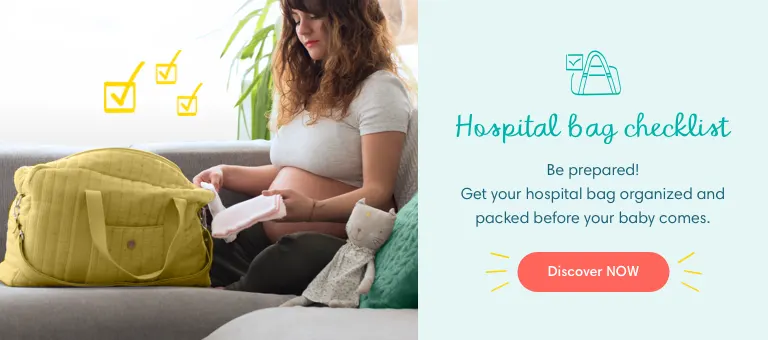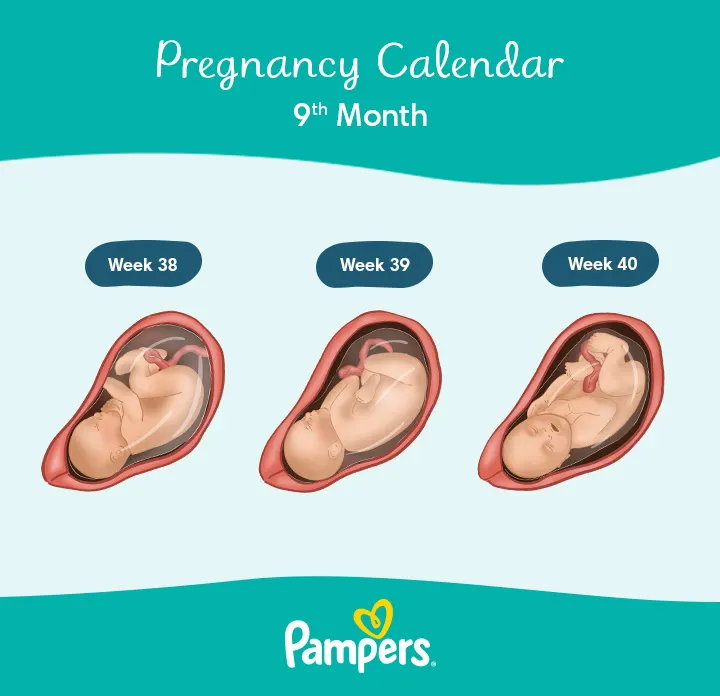9 Months Pregnant
Yes! The end of your pregnancy is in sight now, and the big day is approaching. Keep in mind that your little one isn’t technically considered full term and ready for birth until 39 weeks and that only about 1 in 20 women give birth on their exact due date. So, you both may have a few more weeks of growing to do, but you’re almost there! Read on to learn more about what’s in store for you when you’re 9 months pregnant.
Common Pregnancy Symptoms at 9 Months Pregnant
When you’re 9 months pregnant, some of the normal pregnancy symptoms you might experience include:
Frequent urination. By 9 months pregnant, this symptom might be getting a little old right about now. However, as your baby continues to grow and drop lower into your pelvis in preparation for birth, they also continue to put pressure on your bladder. You’ll probably be making more bathroom trips during the day and at night. If you find that you’re leaking urine when you laugh or sneeze, you may want to wear a panty liner.
Swollen legs. It may seem as if every part of you is bigger now, including your legs and feet. In most cases, extra fluid retention and hormones are to blame. And, as your uterus grows, it puts pressure on certain veins, which can reduce or slow the flow of blood from the lower half of your body to the upper half. To get some relief, put your feet up whenever possible, and avoid standing for long periods of time.
Tingling or numbness in fingers and hands. If you feel a numbness or tingling in your hands or wrists, it could be carpal tunnel syndrome. The carpal tunnel is a system of bones and nerves on the palm side of your wrist. Increased fluid retention during pregnancy can put extra pressure on these bones and nerves, causing that tingling or numb sensation you’re feeling. This discomfort usually subsides after you give birth, but consult your healthcare provider if you’d like to get some relief sooner.
Pelvic pressure. Just like you, your baby is also getting ready for their day of birth. One of the things they’re doing is dropping lower into your pelvis. For you, the downside of this is that you’ll likely feel more pressure on your pelvis, bladder, and hips. The upside is that you may be able to breathe a little easier, because as they drop, they will likely put less pressure on your lungs and diaphragm.
Back pain. Another symptom you may be familiar with by the time you’re 9 months pregnant is back pain. As your belly grows, your center of gravity changes. Meanwhile, pregnancy hormones relax the joints in your pelvis in preparation for childbirth. Both can cause back pain. To give yourself some relief, try to practice good posture (prenatal yoga can help with this), wear supportive, comfortable shoes, and avoid doing any lifting, if possible. A gentle massage or a well-positioned hot or cold pack can also feel good.
Pigmentation. You might be noticing some changes to your skin when you’re 9 months pregnant. Those hormones coursing through your body during pregnancy can increase the production of melanin, which can result in brownish patches appearing on your face (known as melasma) or a dark line down the middle of your lower belly (known as the linea nigra).
Stretch marks. These are a fact of life for many moms-to-be. They’re not preventable, but they often fade after you give birth. Use a gentle moisturizer to keep your skin hydrated and help ward off any itchiness that may come from your skin stretching as it expands to accommodate your growing baby.
How Is Your Baby Developing This Month?
Your baby’s lungs develop right up until birth as they get ready for their first breath and that all-important first cry. Soon you’ll be amazed by how much noise they can make! They’ll also continue to pack on a little more weight—as much as half a pound each week until they’re born.
Once you reach 39 weeks, your pregnancy is considered full term, and your little one could be born any day. Keep in mind, only a small percentage of babies are born exactly on their due date. Most babies are born in the two weeks either side of when they are due.
How Is Your Baby Positioned When You’re 9 Months Pregnant?
At some point this month, most babies move into a head-down position, if they haven't done so already. This is called a vertex presentation. If your baby is positioned with her buttocks or feet first, this is known as a breech position.
If your baby is breech close to your due date, your healthcare provider may attempt to turn them into a head-down position manually; in some cases, you could be offered a caesarean birth if your provider thinks this is the safest option for you and your baby.
It’s also possible that your little gymnast may change positions on their own more than once before they’re born. Your provider will be keeping an eye on their positions at your weekly checkups.
How Big Is Your Baby When You’re 9 Months Pregnant?
By the time you give birth, your baby will be about 18 to 20 inches long and weigh 6 to 9 pounds.
What Does a Fetus Look Like at 9 Months?
Check out these illustrations for a glimpse at what your baby might look like when you’re 9 months pregnant:
9 Months Pregnant: Your Body’s Changes
You might be feeling big, tired, and impatient at this point, and rightfully so!
At this stage of pregnancy, your healthcare provider may recommend a screening for GBS (group B streptococci), which are bacteria that can lead to urinary tract infections in moms-to-be, and, on rare occasions, can be passed to the baby as she moves through the birth canal during delivery. If your test is positive, you’ll likely be given an antibiotic during labour to help prevent passing the bacteria to your baby.
Cramps or contractions can be signs of labour at 9 months pregnant, so it’s important to remember that there’s a difference between Braxton Hicks contractions, which are practice contractions, and the real thing. Here are a few of the main differences you might notice:
| Braxton Hicks contractions | True labour contractions |
|---|---|
| Contractions occur at irregular intervals and don't get closer together. | These come at regular intervals. Over time, they occur more frequently and become more intense. |
| Contractions are usually weak, and don’t increase in intensity over time. | They get stronger over time and might feel more painful. |
| Contractions stop when you move or change positions. | Contractions don’t stop, even if you move around. |
| They’re usually felt only in the front of your abdomen. | The sensation often starts in the back, radiating around to the front. Read more about what contractions feel like. |
If your water breaks, or you notice mucus plug discharge, these are two other signs that your body is getting ready to go into labour.
How Far Along Are You at 9 Months Pregnant?
At 9 months pregnant, you’re so close to the end of your third trimester and your pregnancy! You might still be wondering how many weeks 9 months pregnant is.
If you’re wondering, is pregnancy a full 9 months? Not always. There is no simple answer, as the weeks of pregnancy don't fit evenly within nine distinct months. This final month could start anywhere from 33 to 36 weeks and “end” somewhere around 40 weeks with the birth of your baby.
FAQS AT A GLANCE
At this point in pregnancy, your healthcare provider will measure your fundal height, which is the distance between the pubic bone and the top of your uterus. When the fundal height is measured in centimeters, it usually correlates to how far into your pregnancy you are. So, for example, if you’re 35 weeks pregnant, it’s likely that your fundal height will be about 35 centimeters.
Checklist for When You’re 9 Months Pregnant
□ Ask your healthcare provider under what circumstances your labour might be induced. □ Find out whether you’ll have access to things like a birthing bed, stools, chairs, balls, and pools during labour. □ Pack your hospital bag and practice your route to the hospital. Download our hospital bag checklist for tips on what to pack. □ Ask your midwife to explain what happens in the first moments after you give birth. For example, will you be able to practice skin to skin contact with your newborn, and why the APGAR test is done. □ Put any finishing touches on your baby’s nursery, double check you have all of these baby gear essentials and finish any early baby proofing work you want to get out of the way now. □ Start preparing for some of what you’ll need in the first few weeks and months after you bring your newborn baby home. For example, consider freezing some meals for later, asking friends and family for help with chores, and organizing child care for your older children. □ Read up on the kinds of things to expect in your newborn’s first month to help you feel more prepared. □ By the time your baby is born you’ll have been through a lot with pregnancy, labour, and childbirth all behind you. Take some time now to read up on the postpartum period so you’ll know what kinds of things may be in store for you as your body heals after bringing a new life into the world:
□ Learn more about the diapers and wipes you’ll need when you bring your little one home. Our diaper size and weight chart can help you decide what to buy and how many diapers you’ll need when your little one makes their debut. □ Because you’ve got a lot of diapers in your future, download the Pampers Club app to make sure you’re getting benefits from all those diapers you’ll be buying! □ Now, there’s nothing left to do but rest! Conserve your energy because you have a lot coming up with childbirth, postpartum recovery, and the busy newborn period. You’ve got this! □ Sign up for even more weekly pregnancy tips here:
9 Months Pregnant - checklist
The information in this article is based on the expert advice found in trusted medical and government sources, such as the American Academy of Pediatrics and the American College of Obstetricians and Gynecologists. You can find a full list of sources used for this article below. The content on this page should not replace professional medical advice. Always consult medical professionals for full diagnosis and treatment.


